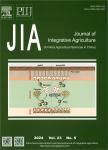Reduction of arsenic bioavailability by amending seven inorganic materials in arsenic contaminated soil
Reduction of arsenic bioavailability by amending seven inorganic materials in arsenic contaminated soil作者机构:Institute of Environment and Sustainable Development in Agriculture Chinese Academy of Agricultural Sciences/Key Laboratory of Agro-EnvironmentMinistry of Agriculture College of Resources and Environmental Sciences China Agricultural University Graduate School of Chinese Academy of Agricultural Sciences
出 版 物:《Journal of Integrative Agriculture》 (农业科学学报(英文版))
年 卷 期:2015年第14卷第7期
页 面:1414-1422页
核心收录:
学科分类:12[管理学] 082803[工学-农业生物环境与能源工程] 08[工学] 0710[理学-生物学] 0832[工学-食品科学与工程(可授工学、农学学位)] 1204[管理学-公共管理] 0830[工学-环境科学与工程(可授工学、理学、农学学位)] 1004[医学-公共卫生与预防医学(可授医学、理学学位)] 0905[农学-畜牧学] 0828[工学-农业工程] 0906[农学-兽医学] 0901[农学-作物学] 0703[理学-化学] 0902[农学-园艺学] 120405[管理学-土地资源管理] 0713[理学-生态学]
基 金:the financial support of the National Natural Science Foundation of China (41171255) the National Scientific and Technology Program during 12th Five-Year Plan period, China (2012BAD14B02)
主 题:arsenic amendment bioavailability Brassia campestris L.
摘 要:Seven inorganic amendment materials were added into arsenic (As) contaminated soil at a rate of 0.5% (w/w); the materials used were sepiolite, red mud, iron grit, phosphogypsum, ferrihydrite, iron phosphate, and layered double oxides (LDO). Plant growth trials using rape (edible rape, Brassia campestris L.) as a bio-indicator are commonly used to assess As bio- availability in soils. In this study, B. campestris was grown in a contaminated soil for 50 days. All of the inorganic amend- ments significantly inhibited the uptake of As by B. campestris. Following soil treatment with the seven aforementioned inorganic ammendments, the As concentrations in the edible parts of B. campestris were reduced by 28.6, 10.5, 8.7, 31.0, 47.4, 25.3, and 28.8%, respectively, as compared with the plants grown in control soil. The most effective amendment was ferdhydrite, which reduced As concentration in B. campestris from 1.84 to 0.97 mg kg-~, compared to control. Furthermore, ferrihydrite-treated soils had a remarkable decrease in both non-specifically sorbed As and available-As by 67 and 20%, respectively, comparing to control. Phosphogypsum was the most cost-effective amendment and it showed excellent performance in reducing the water soluble As in soils by 31% and inhibiting As uptake in B. campestris by 21% comparing to control. Additionally, obvious differences in As transfer rates were observed in the various amendments. The seven amendment materials used in this study all showed potential reduction of As bioavailability and influence on plant growth and other biological processes still need to be further explored in the long term.



